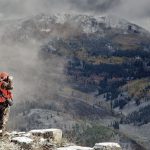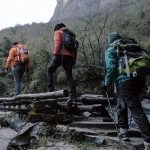Western mountain resorts are adjusting their short-term marketing plans and medium term capital improvement plans in the wake of another unusually dry and warm winter.
In February, Whistler-Blackcomb in British Columbia was shuttling skiers and snowboarders to the bottom of the mountain on lifts due to lack of snow at lower elevations. Snow was even scarce along the trail leading to the Pear Lake Ski Hut that sits at 9,000 feet in Sequoia National Park.
In California, resort officials and civic leaders are scrambling to attract more summer visitors after the disappointing weather shut down resorts early across much of the Lake Tahoe and Sierra Nevada, which is entering the fourth year of drought. The snowpack in the Tahoe region has been below average for each of the last four years and this year brought the driest January and March in the state’s history. In March, snowpack in the Central Sierra was less than 20 percent of average. Squaw Valley, a resort near the north shore of Lake Tahoe, had to cancel a World Cup skiing and snowboarding event in March due to lack of snow.
While Squaw managed to remain open through most of the season, seven other resorts had to shut down their lifts this early this winter due to poor conditions.
Summer in April
In nearby Truckee, CA retailer Tahoe Mountain Sports has adjusted to the drought by steadily reducing the amount of winter gear it carries over the last three winters, according to partner David Polivy.
“I used to order 20 to 40 Black Diamond Whippets in April,” said Polivy, referring to trekking ski poles that have steel ice picks embedded in their handles. “Now I order four or five.”
The store now brings in some summer gear in March rather than waiting until April and May,
“If the snow is not going to come and we have to be profitable, we have to adapt,” said Polivy, who is among the SGB 40 Under 40 inductees who will be honored by SGB magazine at a banquet in California next week. “I never participated in all the Memorial Day marketing, but now we are participating in all of that because we are full on into spring/summer.”
The unusually dry and warm weather has prompted even small community-owned ski resorts like Mt. Ashland in Oregon to consider their future. This spring the Mt. Ashland Association had applied for a permit with U.S. Forest Service it needed to build a zip line, disc golf course and other summer amenities.
“Low-snow years have required the ski area to remain closed for a majority of the past two ski seasons,” notes a May 5 letter from the Siskiyou Mountains Ranger District office soliciting public comment on the application. “Snowpack in future years remains uncertain because of climate change and its associated increased variability to local and regional weather patterns. Mt. Ashland Association would reorient its marketing to reflect a new vision of the ski area as a year-round outdoor recreation opportunity. Climate change has just given one more reason for outdoor brands to invest in new categories aimed at non-core consumers.”
Surveys conducted last year by RRC Associates for the National Ski Area Association show summer visitation grew by approximately 37 percent at 84 U.S. ski resorts that operated during the summer from 2009 to 2013.
But the survey noted that only represented about 50,000 summer visits per ski area on average. Summer revenue grew from 9 to 11 percent of revenue for those resorts over the period, but much of the growth came from non-recreational uses. The survey found that while 81 percent of resorts host weddings and other group functions during the summer, compared to 68 percent that offer hiking. Fifty percent offer XC mountain biking, 46 percent downhill mountain biking, 37 percent disc golf, 31 percent adventure racing and canopy tours, 23 percent ropes/challenge courses. Resorts surveys reported that their summer visitors spent $76 per day on average, excluding transportation and lodging, or about 25 percent less than winter guests.
Resort operators listed alpine slides, water parks and mountain coasters as financial successes, but said hiking, golf and geocaching were money losers. Amenities that required the most infrastructure investment generally generated the best financial returns, perhaps because they were monitored more rigorously.
Major resorts invest millions
Armed with this information and a 2012 law allowing expanded summer uses on the U.S. Forest Service land they lease, larger resort operators are pouring millions into warm weather outdoor recreational amenities.
This summer, Attitash Mountain Resorts, one of 13 ski resorts controlled Missouri-based Peak Resorts Inc., opened a zip line featuring the longest single-zip span in the contiguous United States. At a total length of just under 5,000 feet and reaching heights 250 feet above the forest canopy, the two zip spans offer scenic views of the Presidential Range and Mount Washington in New Hampshire.
In 2013, Vail Resorts Inc. announced plans to invest $25 million to expand summer amenities at six of its resorts. Under its Epic Adventure plan, the company will build zip lines, mountain biking trails, climbing walls, ropes courses and other summer amenities at its Vail, Beaver Creek, Breckinridge and Keystone resorts in Colorado and its Heavenly and Northstar resorts near Lake Tahoe. The company said growing summer visitation at its resorts narrowed normal seasonal losses at its Mountain operations in the fiscal first quarter ended Oct. 31, 2014.
In Southern California, Mammoth Mountain Ski Area, opened a new Adventure Center in 2012 featuring a bungee trampoline, zip line, climbing wall and new mountain biking trails. The company acquired two other southern California ski resorts in late 2014.
Extensive marketing required
Growing summer visitation will also require heavy spending on marketing. Just 13 percent of more than 1,000 U.S. destination travelers RRC Associates surveyed last year planned to visit the mountains during the summer, compared to 20 percent who planned to visit a city, a beach, a casino, a theme park or take a tour.
In California, a fourth year of drought could make the task even more challenging. Polivy notes three of the commercial rafting operations in Truckee have shut down for the summer due to lack of snowfall. He said many people in his community see the biggest threat to their summer tourism business coming from media coverage of how the drought is affecting farmers in California’s Central Valley.
“I got a call from a customer down in the valley who wanted to go to Loch Levon Lake at 7,000 feet,” said Polivy. “He comes up here every year with his family, but he was concerned the lakes are empty. Our lakes, while they may not be full, are still navigable. We are not in the Central Valley.”
Polivy expects tourism promotion organizations around Lake Tahoe to respond with advertising later this month emphasizing that there is plenty of water available in the region for recreation.















